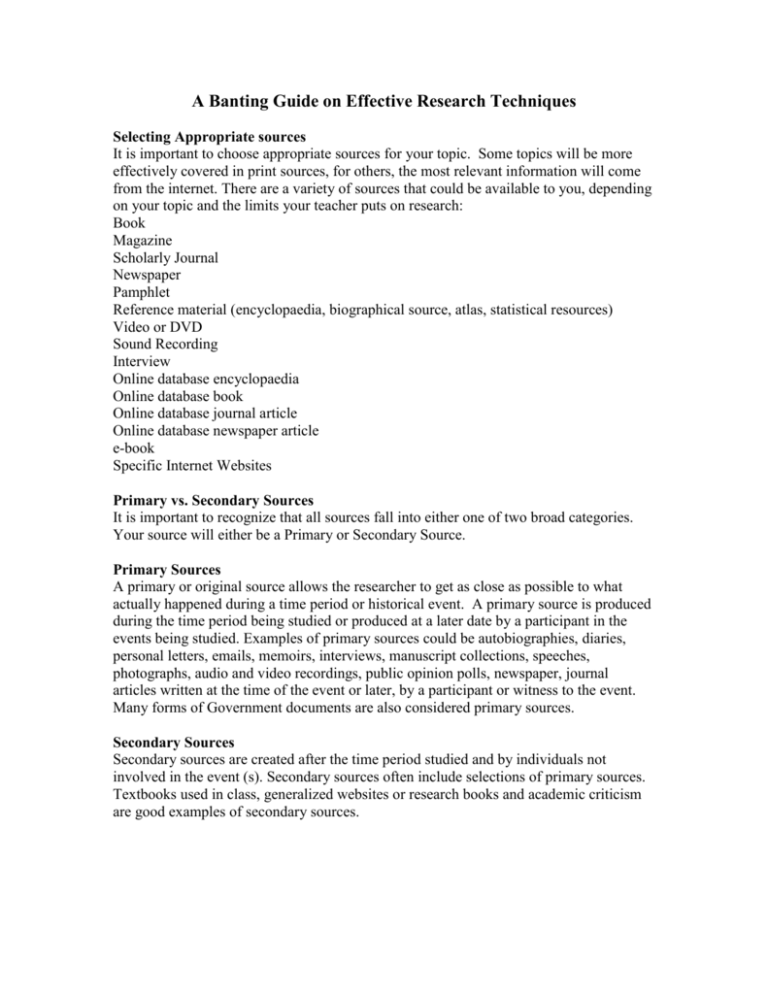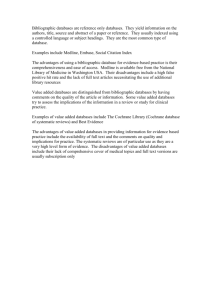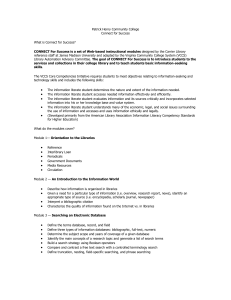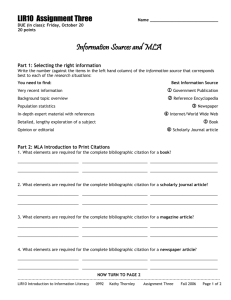Banting Research Skills Guide
advertisement

A Banting Guide on Effective Research Techniques Selecting Appropriate sources It is important to choose appropriate sources for your topic. Some topics will be more effectively covered in print sources, for others, the most relevant information will come from the internet. There are a variety of sources that could be available to you, depending on your topic and the limits your teacher puts on research: Book Magazine Scholarly Journal Newspaper Pamphlet Reference material (encyclopaedia, biographical source, atlas, statistical resources) Video or DVD Sound Recording Interview Online database encyclopaedia Online database book Online database journal article Online database newspaper article e-book Specific Internet Websites Primary vs. Secondary Sources It is important to recognize that all sources fall into either one of two broad categories. Your source will either be a Primary or Secondary Source. Primary Sources A primary or original source allows the researcher to get as close as possible to what actually happened during a time period or historical event. A primary source is produced during the time period being studied or produced at a later date by a participant in the events being studied. Examples of primary sources could be autobiographies, diaries, personal letters, emails, memoirs, interviews, manuscript collections, speeches, photographs, audio and video recordings, public opinion polls, newspaper, journal articles written at the time of the event or later, by a participant or witness to the event. Many forms of Government documents are also considered primary sources. Secondary Sources Secondary sources are created after the time period studied and by individuals not involved in the event (s). Secondary sources often include selections of primary sources. Textbooks used in class, generalized websites or research books and academic criticism are good examples of secondary sources. Using Print Resources While the first instinct of many students is to race to the computer to type in their topic, there are still many instances where print resources will prove as valuable or even more valuable. To begin to search your topic using print resources, start with a generalized search. Stage #1 - Getting an overview: Use your textbook; this is the most logical place to start. Use both the Table of Contents at the front of the book for general chapter overviews and the Index at the back of the book for more specific references. AS you skim the relevant sections, record key terms and personalities related to your specific topic. If your textbook cites other sources, look at those citations and record the author and source to conduct a more specialized search later. In the Library, on your computer, go to the Library web page and click on the PAC icon. PAC stands for Public Access Catalogue (From outside school: http://tlc.scdsb.on.ca and choose Banting to access our library). Type in your general topic under subject and record the call number of any books that may come up. When you look in the stacks for your specific call number, be sure to scan the area around the call number to look for other books on your topic that might not have come up on your PAC search. Look for other general historical texts that address the time period and quickly skim the relevant sections. Use both the Table of Contents and the Index to look up and record key terms related to your topic. Also look for specific citations, and record the source and author. Stage #2 - More specialized research: Look for specific secondary and/or primary sources using the PAC system on the Library website. Type in the search terms and authors that you have obtained from your generalized search. Again, be sure to scan the stacks around your call number to be sure there are not other books on your topic. Throughout both Stage #1 and Stage #2 be sure to record the bibliographic details of every source that you use. Do not return the book to the stacks unless you have recorded the: Author Editor (s) Title Place of Publication Edition # (if relevant) Date of Publication Pages used Navigating the Internet to do Research The Internet is an excellent research source for student research in any subject but only if the researcher knows how to use it wisely. Much information that you could obtain from the Internet is not reliable or credible. The effective researcher needs to understand how to utilize and evaluate the wide range of sources available on the Internet. Using Google and Wikipedia When you first get your research topic you likely will Google it. That is a useful first step but only to get a very general overview of your topic. Keep in mind that: 1) Less than 10% of Google is curriculum relevant and is focused mostly on consumer information; and 2) Websites with a high percentage of information are not updated regularly and may be created by sources that are questionable. From ProQuest Information and Learning, www.il.proquest.com General websites that may appear on your Google search, such as Wikipedia, can, however, be useful in the initial stages of your research. Skim the articles on these sites to obtain relevant terms related to your topic. Also, these sites will often include additional research suggestions. Record authors and sources of these suggested sources to aid you in your future research. Be aware though that some of the information on these general sites might be incorrect. Wikipedia is edited by its users who are not necessarily experts on your topic. Therefore you cannot continue to use Wikipedia as a reliable source. Only use it to obtain research terms. Do not record Wikipedia on your bibliography. You will need to evaluate the credibility and reliability of the websites you used (other than Wikipedia) using the guidelines below. Databases vs. Websites Once you have recorded some key terms on your topic you are ready for a more specific search using the Internet. There are two broad categories of Internet sources that you will find useful: databases and websites. You need to understand the difference. When you use Google, or other search engines like Google, you need to weed through a lot of information to get to something that you can use in an assignment. When you do find a website that looks promising, you need to evaluate the website to determine if the information is accurate and reliable. Use Websites when you: Are willing to evaluate the website's content Want to go to a specific web site Want information on a unique topic Want government information such as tax forms Want other world-wide sites Databases, on the other hand, contain information such as newspaper, magazine, and encyclopaedia articles that have been checked by the database publishers for accuracy and reliability. Use databases when you want: Journal articles Magazine and newspaper articles Encyclopaedia articles Biographical information Statistical information How to use Databases Banting uses the ProQuest MicroMedia databases which include: eLibrary Canada Curriculum: draws much of its content from Canadian publications. Use this database when you need Canadian results. History Study Center: yields results from the History curriculum Literature: yields results about authors, literary titles and criticism SIRS Knowledge Source: focuses on the pros and cons of current issues Keyword versus Subject Headings Keywords: Natural language words describing your topic; a good way to start your search. Subject: Database looks for subjects only in the subject heading or descriptor field. Results are usually very relevant to the topic. Search Types: Keyword, by Topic, by Publication, and by Reference All Databases are organized around the search function. Keyword Search: Basic and Advanced Start with Basic search when you’re looking for information to help to narrow your topic. Examine your results for keywords and subject areas that you can add to your search to get better search results. This might lead to a more specific thesis Advanced search when you know exactly what you’re looking for: keywords, subjects, modifiers. You can specify Canadian content only, academic journals only, reading level, and media type. Topic Search: Takes you to a breakdown of a Subject area. Use it to refine your search. Publications Search: Search for a specific publication by name (e.g. Globe and Mail), by type (e.g. magazine), by Subject (e.g. History) Reference: Use reference media to search content and to edit your work. e.g. encyclopaedia, atlas, dictionary, thesaurus, etc. Media types are represented with visual icons e.g. newspaper, microphone, camera to help you to identify the media type in your results. To narrow your results clear media types and choose only the media you wish to see in your results e.g. newspapers and books, but not images, maps, transcripts, audio/video. Evaluating a Website Before you can use a website as a research source you need to evaluate it for reliability (the extent to which the information is accurate) and credibility (the provider of the information has some level of recognized expertise in the subject). When looking at a site, you should be able to determine the following: Who is the source for the information? Is it an individual, an institution, an organization or a company/corporation? Is the information that is establishing the authority or credibility of the author clearly stated if it is not obvious? If your website does not indicate a clear, credible author, it is not a useful source. When was the source written/produced? How current is it? When was it last updated? Is your topic time sensitive? Question the reliability and credibility of sites that do not include dates anywhere. For what purpose was the source created? What is the bias? Be aware of the type of organization that posts information on the Internet. The type of organization behind a website can give some clues to its credibility. Use this guide to help you understand the differences between organizations that post info on the Internet: .gov In the US, .gov applies to federal departments. In Canada, provincial governments use .gov followed by a provincial or territorial abbreviation and .ca. .gc The federal government in Canada uses .gc in its domain name and in the domain names of many of its departments, such as Industry Canada and Canadian Heritage. However, some government Web sites, such as the Canadian Human Rights Commission (www.chrc-ccdp.ca), opt for just .ca. .ca The Canadian Internet Registration Authority (CIRA) is the non-profit corporation responsible for overseeing and keeping a registry of the ".ca" Internet country code domain for Canada. Schools, educational organizations, libraries, museums, and some government departments may be registered under a 2-digit country-of-origin code, such as .ca, .uk or .au. However, it's important to remember that any Canadian organization can obtain a .ca domain. .edu The United States originally created .edu to indicate American colleges and universities offering 4year degree programs. Most Canadian universities tend to use .ca. .org .com .net Back in the early days of the Web, .org indicated a wide assortment of groups, including non-profit organizations; .com indicated commercial organizations; and .net was intended for organizations directly involved in Internet operations, such as Internet service providers. Now, anyone can apply for, and use, these letters in their domain names. For example, the YWCA site in Oakville ends with .com, in Vancouver, it ends with .org, and in Montreal it ends with .ca. From: www.media-awareness.ca A fun way to practise evaluating websites for reliability and credibility is to use this site: http://www.vts.intute.ac.uk/detective/brief.html Citing your Sources and Creating a Bibliography Whether you are using text or Internet sources, you must indicate where you got your information from. At a minimum you will likely be asked to produce a bibliography. The more advanced project/paper will also require you to cite your sources as you use them in your write up. Citing Text Sources Citing text sources is quite straightforward. To do this, be sure to record the following: Books Author Editor (s) Title of document Edition # (if relevant) Place of Publication Publisher Date of Publication pp. Magazines or Newspapers Author Title of Article Name of Magazine or Newspaper Volume Number (if relevant) Date of Publication pp. Citing Internet sources Remember that when using Internet sources, you have to acknowledge the source that you got the information from. However, there are so many sources on the Internet available to you that there is no generalized, generic formula to recommend how you record that information. What you must do, as a start, is write down the URL address, and then for the formal citation, seek advice from your instructor as to which format he/she wants you to use to record the specific bibliographic information. Methods of citing sources and the bibliographic style that you use will depend both on the discipline for which you are doing the research and your instructor. There are three standards for acknowledging source material, the APA, the MLA and Chicago style. You will need to seek directions from your specific instructor as to how he/she wants you to acknowledge and record your sources. The Annotated Bibliography: Testing your Research Skills You are required to find a number of different sources on a specific topic and for each indicate why that source would or would not be a valuable source. For each source that you find, you must record it in proper bibliographic style using the guideline provided to you by your teacher. Topic: General Print Source on your topic After you have recorded your source in proper bibliographic style, provide a brief description (annotation) that explains how this source would be useful for your topic. Specific Print Source on your topic After you have recorded your source in proper bibliographic style, indicate two specific facts that you have learned about your topic from this source. A website that you have evaluated for reliability and credibility and judged to be useful After you have recorded your source in proper bibliographic style, explain why/how you have determined that this is a reliable and credible site. A website that you have evaluated for reliability and credibility and judged to be not useful After you have recorded your source in proper bibliographic style, explain why/how you have determined that this is not a reliable and credible site. A source from a database After you have recorded your source in proper bibliographic style, indicate two specific facts that you have learned about your topic from this source A primary source on your topic After you have recorded your source in proper bibliographic style, describe what new insight this source will provide for your topic.





